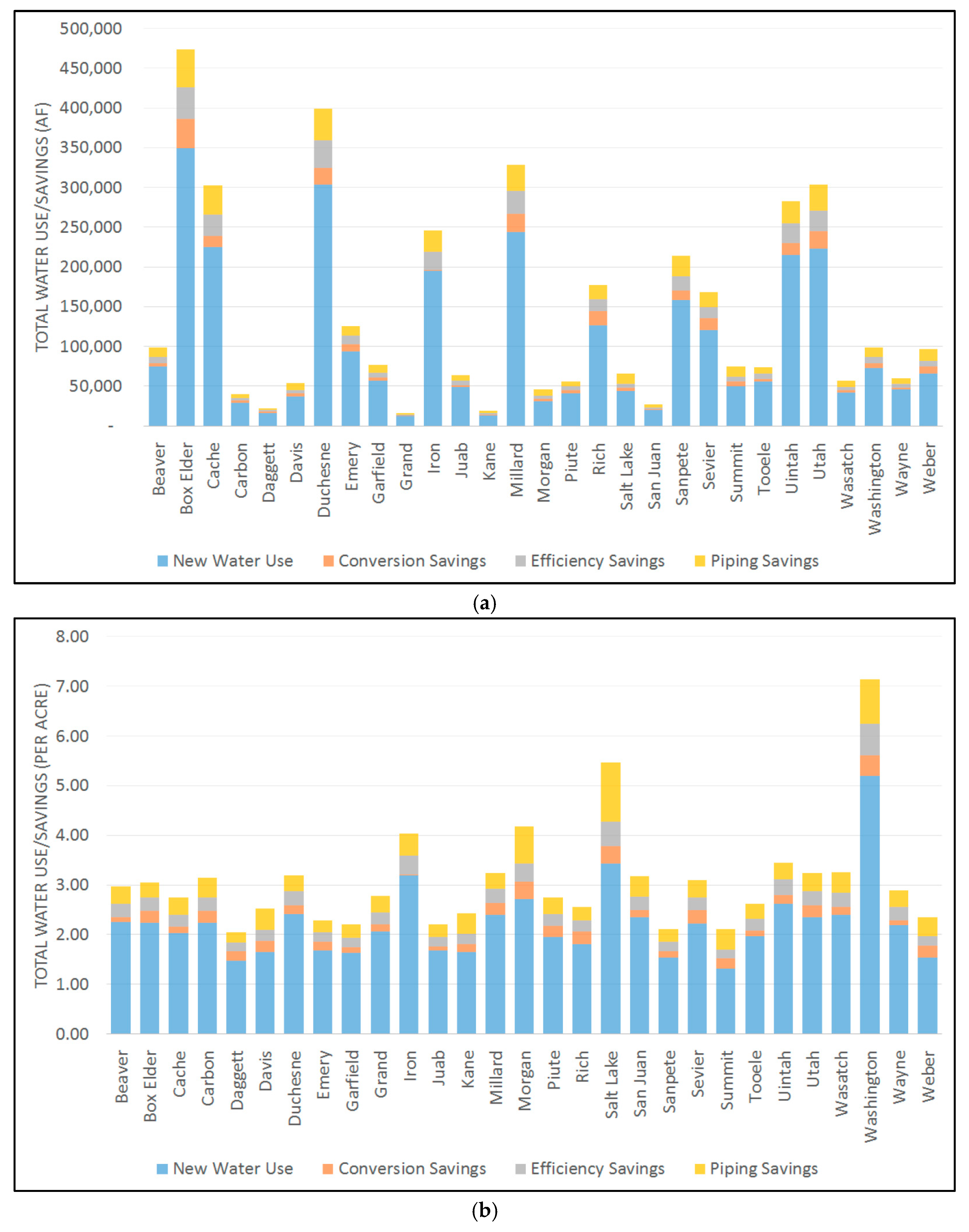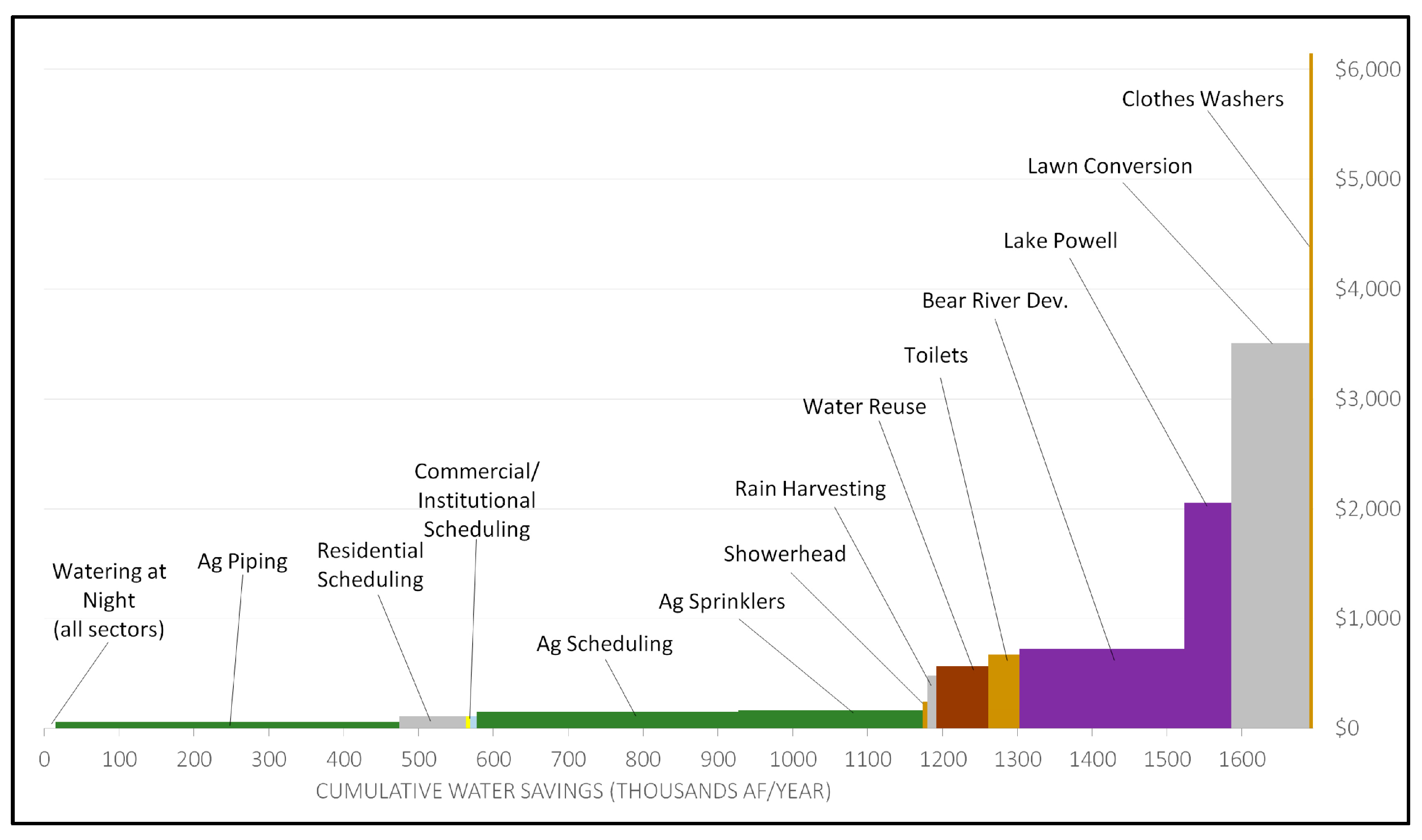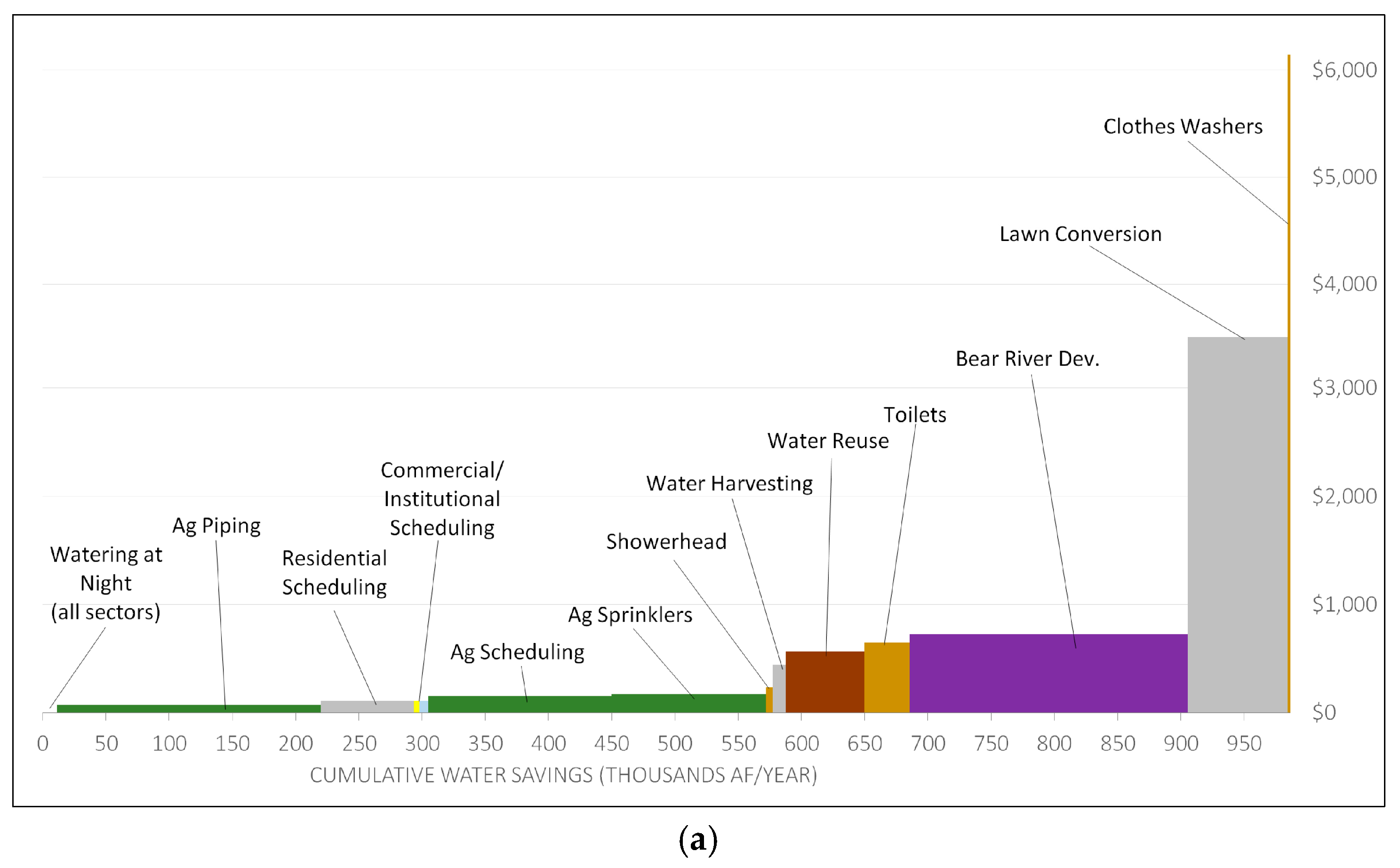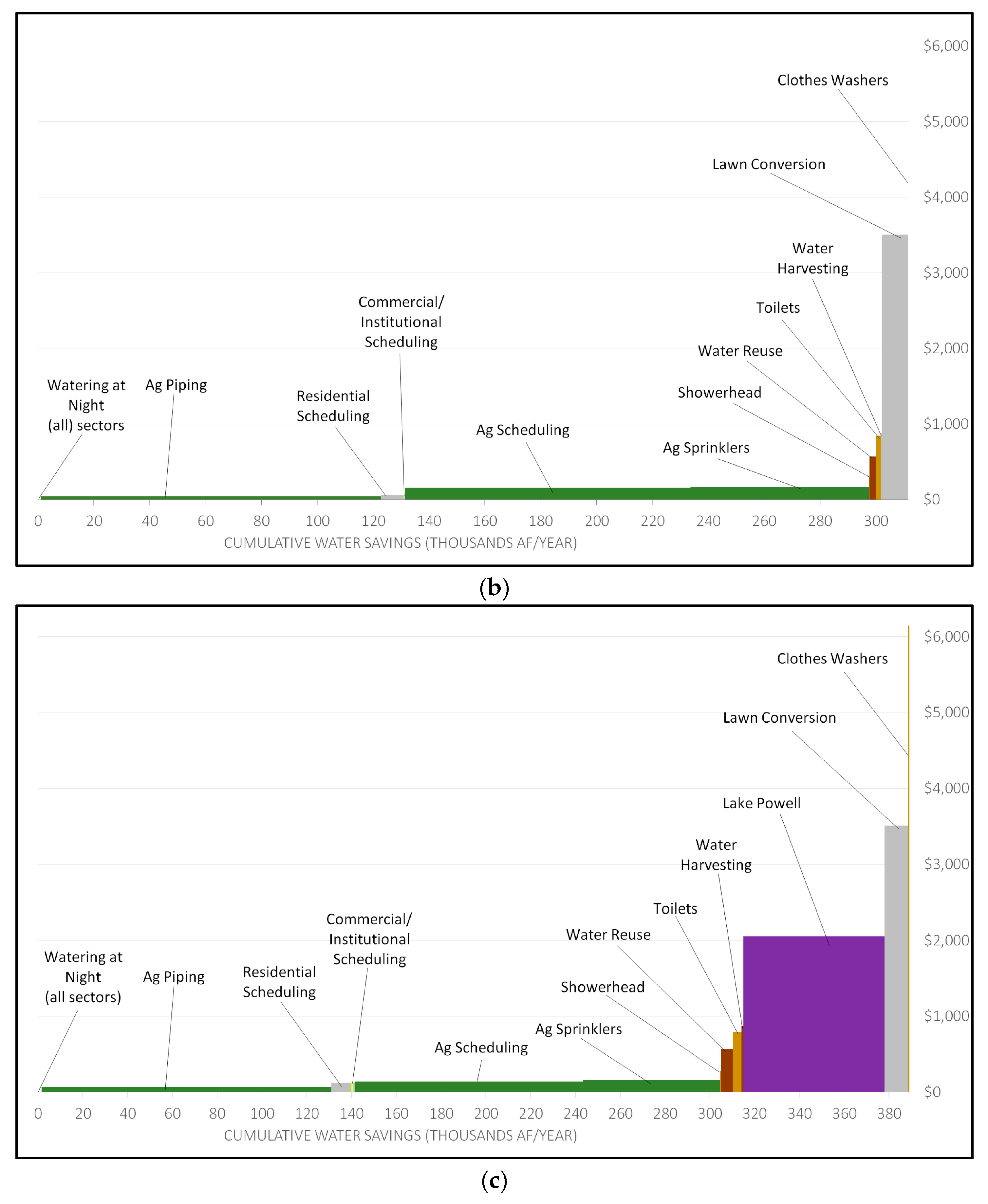1. Introduction
Acquiring sufficient water supply to meet demand has been an ongoing concern in the western US. Growing urban demand has strained limited water supplies and increased pressure on the institutions governing transfers to allow more water to move from agriculture to other uses [
1]. Additionally, rising demand for environmental flows and associated protections of riparian ecosystems has placed constraints on both new and existing supplies [
2,
3]. The Endangered Species Act (1973), National Environmental Policy Act (1970), and wetland protections under the Clean Water Act (1972) are examples of the types of restrictions placed on existing and new water supply options, limiting where, when, and how much water can be removed from natural systems. Finally, climate change will likely change the variability, amount and type of precipitation, and subsequently the availability of water [
4].
In a well-functioning market, shortages are generally addressed by increasing prices, which spur conservation and the development of additional supply. However, the allocation of water in the western United States is determined under the rules of the appropriative rights doctrine, which assigns property rights to water by the historic order of request. This is referred to as “first-in-time, first-in-right” because senior appropriators receive their water allocation first in times of shortage. Agriculture has historically been the primary use of water, and most senior rights rest with irrigators. Like other western states, a majority of Utah’s developed water supply was and continues to be used in agriculture.
Market price mechanisms do not generally exist for water as in other goods. The institutional arrangements associated with the appropriative rights doctrine determine that many water users do not pay the full scarcity cost of the water they use. Moreover, these institutional arrangements also generally place restrictions on water sales, especially those which move water out of agricultural production [
2]. These barriers to the transfer of water rights can lock water resources in low-value uses, and create scarcity in sectors that would otherwise simply purchase water rights. Given these institutional restrictions, it is worthwhile to examine to what extent water scarcity can be addressed by reducing demand and increasing supply, and the relative costs of different approaches.
A lack of water markets with clear price signals creates difficulty in evaluating the cost effectiveness and social value of water supply development projects and other policy proposals. For example, in the state of Utah, two proposed development projects, the Bear River Development Project and the Lake Powell Pipeline, are currently the subject of public debate. Although the costs of these projects can be estimated via conventional techniques, the lack of price signals from water markets obfuscates the cost of other policy options that could provide an equivalent supply of water. Estimating the cost of conserving water, rather than developing new supplies, offers one approach for examining the opportunity cost of development projects. Furthermore, conservation options may not be priced into markets where they exist because irrigators are often not able to sell conserved water. When agricultural irrigators, and to a lesser extent residential irrigators, do not see direct monetary benefits from conserving water, they have little incentive to do so. In agriculture, conserved water may not be retained by the irrigator who conserved it, and often cannot be sold into other sectors [
5]. Irrigation also represents the two largest categories of water use in the state, with agriculture accounting for 82% and residential outdoor accounting for 6% of total water use [
6]. Therefore, we hypothesize that the largest conservation savings at the lowest prices will come from agricultural and urban irrigation.
The key contribution of this paper is to provide a “big picture” assessment of the costs associated with expanding the water supply though various policies and technologies. Although our estimates for any single conservation method should not be viewed as authoritative, we provide a general methodology for organizing information on the relative costs of various policies designed to conserve water supplies in Utah. The estimates provided herein can be easily updated and expanded as better information becomes available and new policies or technologies are developed. Our methodology is similar to the approach taken by Granade et al. in their report
Unlocking Energy Efficiency in the U.S. Economy [
7]. This report provided a clear graphical representation for a comparative assessment of different technologies in terms of cost and the amount of energy savings. This paper constructs a similar representation for a water efficiency supply curve to that of [
8]. However, relative to electricity, water is a more localized commodity due to its high transportation cost, so we chose to focus on a constrained geographic area by developing estimates for the state of Utah. This is the first paper we are aware of to provide a direct comparison of conservation measures at the state and sub-state level interpretable by policymakers, water agencies, and water users.
Data is gathered on six potential categories for water conservation: residential indoor, residential outdoor, commercial, wastewater, agriculture, and water resource development. Within each area, multiple conservation technologies were selected based on their relevance to Utah water conservation. While not as comprehensive as other estimates, (e.g., [
9]), this work is designed to better illustrate the economic tradeoffs and barriers to water conservation. Current water use in Utah is estimated at around 5.15 million acre-feet (AF) per year [
6], and in total the measures we consider could provide up to 1.7 million AF through conservation and new supply development. The cost of providing this water varies dramatically, from behavioral changes such as watering at night that cost nothing in monetary terms, to expensive landscape conversion costing around $3508 per AF saved.
Findings indicate that the largest potential water savings, at the lowest costs, are in agriculture and outdoor residential water use, where more efficient use of water can maintain acreage of crops and lawns at current levels while dramatically reducing use. Cost estimates for development projects, such as dams, are higher than many conservation technologies, even as these projects are seriously considered as viable supply options for the state of Utah. While conservation potential exists in agriculture, it is important to acknowledge that significant barriers to conservation exist, and even if conservation methods were adopted, they might not result in the movement of water to high value uses. For instance, subsidies for irrigation efficiency may not lead to reduced water usage, as the conserved water is applied to additional agricultural land and reduces return flows [
10].
2. Methodology
We estimate a water efficiency supply curve for various water conservation measures in the state of Utah. The correct metric for measuring water use efficiency, especially in agriculture, is the subject of debate [
11] and efficiency savings estimates that fail to account for return flows to the hydrologic system may overestimate actual water savings [
12]. To address these issues, we define water efficiency as any technology, behavior, or system adjustment that conserves water without decreasing the direct benefits provided by the water in its original use. Thus, when the conservation of water decreases directly used return flows, savings are adjusted to the consumptive use only. This definition separates water supplied through conservation from water supplied via sales, transfers, or reallocations. We offer a comparison of various conservation approaches based on engineering and behavioral savings estimates. These comparisons can be used as a tool for policymakers to understand both the options for water conservation and the barriers that raise transaction costs and prevent the implementation of many seemingly low-cost conservation approaches.
To organize potential conservation measures, we designate six categories: residential indoor, residential outdoor, commercial, wastewater, agriculture, and development. Within each category we select a number of important water conservation measures.
Table 1 provides a listing of the measures considered by each category. Overall we estimate the conservation potential and cost savings of 15 measures which were selected from a broader survey of potential measures. The list is not meant to be comprehensive. Instead, efforts were made to include measures that were widely discussed in the popular press, by professionals in the field, and in various disciplinary literatures. Because this project primarily focuses on Utah, some measures are specific to the potential water supply available in the state.
Research on each conservation approach was conducted to create an estimate of the quantity of water that could be conserved, and the cost of conserving that water. In economics, the short term is characterized by the adjustment of factors to provide the most efficient outcome given a fixed method of production. In the long term, the production process itself can be modified, changing the relationship between the factors of production. The majority of the measures considered are long-run, requiring an up-front capital investment to conserve a quantity of water for some period. For consistency, we generate a cost per AF per year. Given a project producing a quantity, Q, per year for a total cost K, lasting a number of years, t, we apply the annuity formula to find the per-year fixed cost,
:
where
r is the interest rate assumed across all approaches to be 5%. We add any annual cost,
, such as maintenance, to arrive at the per year cost,
. We then define the per AF cost as
.
The project cost is estimated by assessing all direct project expenditures, but excludes the opportunity cost of using water in a particular way. In general, this is straightforward: an approach to conserving water may require investment in technology, training, and construction, and all these costs are included. The alternative uses to which the water could be put, however, are excluded—these are the uses for which the conserved water can be applied, i.e., the demand curve. Environmental costs that are directly incurred, like payments made for required environmental mitigation, are included but costs that will not be directly borne are not. This approach is potentially problematic when conserving water creates large direct but unpriced environmental costs, for example a large dam development makes additional water available at the expense of ecological benefits provided by a flowing river. However, for practical reasons this approach is necessary: unpriced environmental benefits require empirical estimation beyond the scope of this paper. We return to environmental impact in detail in the discussion section of the paper.
We estimate the cost and useful life of the equipment as well as the amount of water made available by each conservation method using various sources including the available academic literature, governmental reports, and interviews with experts. The methodology and sources used for estimating the cost of each conservation method are described in detail in the Results section. To estimate the amount of water made available, technologies are scaled based on the total number of potential adopters. The baseline assumption is that any technology can be supplied at its estimated cost to the entire population of users who have not yet adopted it. The supply curve is constructed using our estimates of per-AF cost and the total potential quantity saved: the per-AF cost is plotted on the y-axis and the quantity conserved on the x-axis. Given n-conservation methods, we order them such that:
. Then we plot them, such that:
For the ease of interpretation and calculation, conservation methods in this paper will form a step function. However, this method is generalizable to methods with upward sloping cost functions, with Equation (2) modified to sum continuous functions horizontally.
4. Discussion
Our results indicate that large potential water savings are achievable at a reasonable cost in Utah via conservation. Much of these potential savings come from agricultural and to a lesser extent urban irrigation, confirming our hypothesis that these sectors offer low-cost alternatives for water supply. As discussed in the introduction, growing urban demand is placing significant pressure on western water supplies, and high population growth and urbanization in Utah make understanding urban water supply options important to both policymakers and the general public [
19].
Table 6 explores the growing urban demand in Utah’s six most populated counties. Current water use in these counties ranges from .24‒37 AF per person annually (authors’ calculations based on data from [
18,
40]). Current water rates for representative cities are also included in the table [
41,
42,
43,
44,
45,
46]. Increases in population are expected to lead to increased demand for water supply. The added demand column calculates an upper bound estimate of future water demand based on current per capita water consumption and projected population growth. These calculations are likely to be overestimates of future urban water demand as per capita water use has been steadily decreasing in western states over the past few decades [
47].
One potential use of a water efficiency supply curve is for policy makers and the public to examine the full range of options for providing water to growing urban areas. All the counties in the table except Washington are located in northern Utah. By 2060, these northern counties are projected to see population increases totaling 2,241,230 [
40]. This increase will require 564,213 additional AF of water at current per capita use rates. Using the cost curve for northern Utah,
Figure 4a, the upper bound estimate of required urban supply could be met by undertaking only water conservation measures up to installing agricultural sprinklers. This water could be made available at or below a cost of $171 per AF, less than what most urban water users in these counties are currently paying, and substantially less than the per-AF cost of the Bear River Development Project.
Yet there are barriers to the use of water conservation savings to meet growing demand. In the short term, some of the potential water efficiency projects may not be feasible. For instance, a ditch-lining project would not address intra-year urban water shortfalls. This suggests the efficiency cost curve would be most useful in a long-term planning process, which would also enable planning for issues surrounding the potential environmental impact of the conservation measures. If efficiency savings are transferred out-of-basin, return flows and overall environmental water availability could decrease. This would be the case in northern Utah, where the highest water-use counties are not in the same basin as the highest demand-growth counties. A potential solution would be to introduce rules that limit transfer volumes to prior consumptive use [
48].
Development projects such as dam and pipeline construction also have large environmental impacts that are not fully accounted for in the efficiency cost curves. Where possible, we include environmental mitigation costs. For instance, the Bear River Project would require substantial wetland mitigation, and this cost was included in the per AF cost estimates. However, other impacts are not included, for instance the effect of additional water diversions on the level of the Great Salt Lake, which in turn degrades ecosystems and can result in dust storms and other environmental problems [
49].
Planning for how conservation savings can be moved to high-demand sectors is also an important aspect of using the efficiency curve. In some cases, new transportation infrastructure may be required, and construction and energy costs should be added to the per acre foot estimates when relevant. By examining the efficiency curves of more confined geographic regions, the impact of transportation costs will be reduced. Even when these costs are relatively low, rules against waste and third-party damages in most western states may limit the ability of right holders to transfer conserved water [
50]. Farmers may fear partial forfeiture of their water right if conserved water cannot be put to immediate beneficial use on their farm [
51]. Furthermore, their ability to transfer the water to a different sector may be opposed by other irrigators or environmental advocates [
2]. Regulations locking water into agriculture can significantly depress water right value [
52], making investments in even low-cost conservation projects uneconomical. Alternatives like development projects have high relative costs, but may be partially or fully publicly funded, delivering benefits to key interest groups [
53,
54]. Although the efficiency curve suggests water savings at low prices in agriculture, calls for farmers to increase efficiency without a mechanism to pay for conservation investments are unlikely to be successful. Economists have argued that the ability to transfer water makes each user account for the opportunity cost of its use—a necessary, although not sufficient, condition for improving water allocations [
55].
Individual perceptions and behavior can also limit the adoption of water conservation. A nationwide study into individual perception of water use indicated that, on average, Americans underestimate the water use of common activities by a factor of two [
56]. The same study found that when asked about ways to conserve water, people incorrectly considered behavioral changes to be more important to water conservation than upgrades. Another concern surrounds consumer acceptance of HE fixtures [
57]. Though HE appliances have been around for over a decade and have benefited from continued innovation and national standards, there may be some lingering concerns over the effectiveness and durability of the fixtures. A 1999 survey of 1300 Ultra Low-Flush (ULF) toilet buyers in California concluded that “overall most consumers prefer their new ULF toilets to their old toilets [
58],” while data on showerheads show a slight negative correlation between flow rate and customer satisfaction [
59]. Other conservation areas are also affected by preferences and knowledge. Water reuse requires consumer buy-in, and there are potential obstacles in terms of environmental and human safety, and especially the social perceptions about the cleanliness of reused water [
24]. Finally, the lack of knowledge about irrigation scheduling is likely a key barrier to its greater adoption [
60].
The presence of barriers to effective implementation of the conservation measures discussed in this paper indicate that the efficiency curve is likely to be most beneficial as a tool in identifying conservation opportunities as part of a long-term planning process. This would provide time to overcome political, environmental, and educational barriers to conservation and provide adequate time for implementation of projects requiring longer leads.










